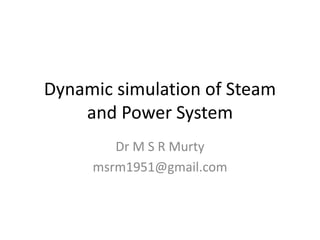Dynamic simulation of Steam and Power System.ppt
- 1. Dynamic simulation of Steam and Power System Dr M S R Murty msrm1951@gmail.com
- 2. Stream Generators LP Process VHP HP MP PRDS Process Process Process HRSGs UBs G Typical Steam and Power System Headers 107/ 510 45/ 400 20/ 340 5.5/ 220 Kg/Cm2 o C C G GAS TURBINE G Steam Turbine
- 3. Captive Power Plant - General Overview NAPHTHA GAS OIL GAS TURBINE NAPHTHA GAS OIL 8 X 125 TPH HRSG AUX BOILERS 4 x 125 TPH Refinery Fuel Oil STEAM TURBINE HP steam 42 Kg/cm2 MP steam 17 Kg/cm2 To Refinery Power Steam INSTALLED CAPACITY 360 MW 1500 TPH PRESENT GENERATION 269 MW 979 TPH EXPORT TO GEB CAPABILITY 80 MW ------------ TO GEB 132/220 kV TO REFINERY 4 X 30 MW 8 X 30 MW 11 KV 33 KV 33 KV 11 KV Reliance Jamnagar
- 4. • All 4 STGs are tested to deliver 30 MW of power. • Steam turbines are provided with HP and MP extractions • Maximum steam flow through one steam turbine shall be as follows 262 TPH HHP steam (Max) Pr: 109 Kg/CM^2 @ 505 DegC 180 TPH HP steam (Max) 149 TPH HP steam (Normal) Pr: 44.8 Kg/CM^2 @ 383 DegC 80 TPH MP steam (Max) 53 TPH MP steam (Normal) Pr: 18.8 Kg/Cm^2 @ 282 DegC 60 TPH to Condenser (Max.) 20 TPH to Condenser (Min.) Steam Turbine MP 133 TPH LP 60 TPH Normal steam flow HP section =15.27 MW MP section = 5.73 MW LP section = 11.81 MW Reliance Jamnagar
- 5. Typical Steam and Power System • 8 GTGs, 4 STGs (extraction types) • 8 HRSGs, 4 Aux Boilers • Steam generators and Consumers within Process • Turbine driven equipment in Process • Limits on Header pressure:+3 %,- 10 % Temperature: + or – 10 %
- 6. Set point Process Steam Pressure STEAM GENERATORs V H P H E A D E R GOVERNING SYSTEM G UPSET : SUDDEN STEAM DEMAND CHANGE MP LP tph sec
- 7. Set point Process Steam Pressure STEAM GENERATORs V H P H E A D E R GOVERNING SYSTEM G UPSET : STEAM TURBINE TRIP MP LP
- 8. C ST G G G GAS TURBINE Div Damper HRSG VHP STEAM HEADER Upset: GT TTRIP or HRSG Trip Fuel Inlet Air
- 9. Steam and Power system Dynamics Steam System Power System Fuel System Upsets in one system can influence the other
- 10. Header Pr Variations For T-C Upset
- 11. Steam Flows for Upset condition
- 15. Summary • Dynamic simulation helps in predicting transient deviations in critical process parameters • Tuning of control system parameters can be done based on simulation study • Different control strategies can be evaluated















